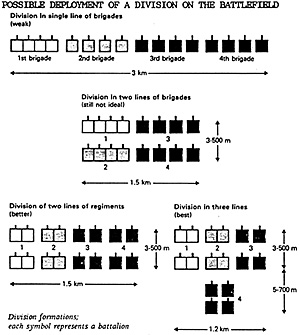
INTRODUCTION
Deployment of troops on the battlefield is a constant source of confusion. some wargamers home preconceived ideas that are not always conform to what took place. So, the following is a quick but limited survey on how Continental Napoleonic armies deployed on the battlefield.
TYPICAL LINEAR DEPLOYMENT IN THE 1700s
1ST LINE:
xx xx xx xx xx xx
CAVALRY INFANTRY CAVALRY
2ND LINE
xx xx xx xx xx xx
CAVALRY INFANTRY CAVALRY
RESERVE..............xx xx xx xx
CAVALRY INFANTRY CAVALRY
SOME IMPORTANT DATES
1759: CREATION OF PERMANENT DIVISIONS IN FRANCE
1794: CARNOT DEVELOPS THE DIVISION EMBRACING THE 3 ARMS. BECOMES UNIVERSAL BY 1796.
1800: MOREAU CREATES THE CORPS SYSTEM BECAUSE IT'S IMPOSSIBLE TO COMMAND ARMIES OF 200,000 WITH 10-12 DIVISIONS.
EACH CORPS EMBRACES THE 3 ARMS. IT'S IN FACT A SMALL ARMY IN ITSELF.
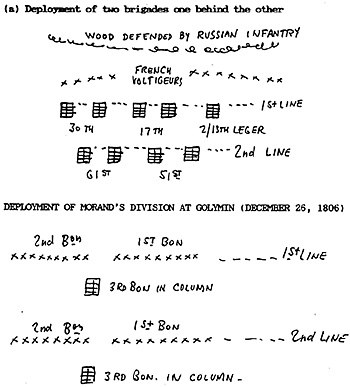 Marmont in The Spirit of Military Institutions or Essential Principles
of the Art of War, p. 178-9, gives his opinion - and the fundamental principles - on how to deploy an army for
battle:
Marmont in The Spirit of Military Institutions or Essential Principles
of the Art of War, p. 178-9, gives his opinion - and the fundamental principles - on how to deploy an army for
battle:
- "...I will state .... there has been adopted, as a fundamental principle,
the formation of troops on many lines. The first line deployed, the second in
column by battalion, at deployment distance, ready, if there is need, to march
or to form into line; and a third line composing the reserve, in column by
brigades, ready to march wherever it can became useful.
I will, however, make one observation upon general dispositions; it is that the command of troops should be devised so as to embrace the two lines at once; that is that these corresponding parts be under the direction of the same commander. The reason for this is easily conceived. As the second line is destined to sustain the first, it is necessary that the movements of the corresponding fractions in the two lines agree perfectly. It is not the same with the reserve; it forms a complete and independent corps, which should have all its means united to act according to the circumstances; thus a "Corps d'Armee" of 4 Divisions, in disposition to offer battle, should have, in my opinion, the following formation:
In the first line, three brigades of three different Divisions, and in the second, the three other brigades of the same Divisions, and the fourth Division in rear, entire, and formed in two masses, each of a brigade... " (Try to have wargamers to do that! JAL)
As to the artillery, that constituting the reserve should hold itself in rear of the infantry reserve, ready to move wherever it should be needed."
Borodino
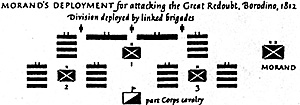 Zwegentzov in L'Armee Russe, p. 430, gives the general deployment of
the Russian army at Borodino:
Zwegentzov in L'Armee Russe, p. 430, gives the general deployment of
the Russian army at Borodino:
- "The position is divided in Army Corps sectors, each having its artillery
support position. The infantry units are located near these artillery support
position, the 2 Divisions of the Corps each occupying a sector, that on the
right and that an the left. The Jeagers (except the 33rd and 34th) are all
deployed in skirmish order in front of the line infantry, With their reserve in
close order. The line infantry is formed on two lines of battalion columns (in
2nd line are the 2nd battalion of the regiments). The distance between the two
lines is 200 paces. The cavalry corps are placed behind the infantry Corps, on
2 lines, the squadrons deployed in line. Part of the cavalry is deployed in the
intervals between the infantry Coxps. The light artillery of the Divisions is
with their Divisions. The heavy artillery "of position" is in the hearth works.
In reserve are the light and heavy guns concentrated behind the center of the
defense system."
 As mentioned above, opinions varied on the best methods of deploying a
Division. Colonel Robert Home in Precis of Modern Tactics, London,
1882, page 48 had some comments on Napoleon's tactical directives on French
infantry formations to be used at Austerlitz and is not in favor of
deploying two brigades behind one another:
As mentioned above, opinions varied on the best methods of deploying a
Division. Colonel Robert Home in Precis of Modern Tactics, London,
1882, page 48 had some comments on Napoleon's tactical directives on French
infantry formations to be used at Austerlitz and is not in favor of
deploying two brigades behind one another:
- These dispositions (that of Napoleon, JAL) are a further instance
of the fundamental rules in infantry fights, that the second line must not be
independent of the first line, of which it is the support and immediate stay.
The order of linked brigades was thus conformable to what history shows had occurred in every battle. The ground of a battlefield is generally so cut up by obstacles, and so formed, that each brigade has usually a distinct object to attain.
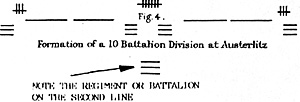 The second line can hardly, if ever, support the first line without
forcing it again into action, for the passages of lines, as laid down in
books, can rarely, if ever be carried out. These formations are also a
condemnation of the system of deploying an entire Division in front line, and
an entire Division in second line ......
The second line can hardly, if ever, support the first line without
forcing it again into action, for the passages of lines, as laid down in
books, can rarely, if ever be carried out. These formations are also a
condemnation of the system of deploying an entire Division in front line, and
an entire Division in second line ......
I have several points of disagreement with Colonel Home's above comments. (Let us not forget that his view reflected the tactics of 1880 greatly affected by the long ranged high power rifle and artillery.) There are:
 (1) The order of linked brigades, or two brigades deployed side by side, was
not used in every battle. From our survey, the deployment one brigade behind
the other was extensively used.
(1) The order of linked brigades, or two brigades deployed side by side, was
not used in every battle. From our survey, the deployment one brigade behind
the other was extensively used.
(2) The passage on lines, was not impossible to perform. On the contrary, it was a simple maneuver to carry on. As a matter of facts, it was not only practiced by the French according to the Reglement of 1791 but also by the Russians. At Eylau, Bagration performed the passage of lines by simply treating his command through the intervals of Barclay de Tolly-s Division which was in columns.
On Large Columns
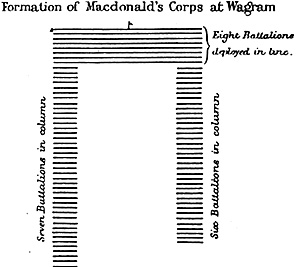
Following is what Oman says in Studies, still considered by many as the gospel truth:
- It ever may have been the Emperor's theoretical preference for the ordre
mixte, his most celebrated battle-strokes seem generally to have been made by very
gross and heavy masses. The worst instances, Mcdonald's column at Wagram and
D'Erlon's first disposition at Waterloo, both perfectly monstrous formations -
in the way of depth, they're not ordered or authorized by the Emperor, but it
is clear that in many other cases the advance of solid undeployed masses was
permitted or approved by him. The ordre mixte was only a "counsel of
perfection". At its best it was still a very heavy formation.
So, here is Oman's perception of Macdonald's formation at Wagram: a monstrous column, which of course can be considered as such. But let US Bee what Macdonald says in Marshal Macdonald's Recollections , p.338, say about his formation at Wagram:
- "...I therefore ordered four battalions, followed by four others which I
deployed in two lines, to advance at the double; and while my artillery opened
fire, and that of the Guard took position (which the Emperor called the
huundred gun battery), my two divisions formed themselves into attacking
columns. The enemy, who were still advancing, halted, and, redoubling their
fire, caused us terrible damage. However, in proportion as my lines became
unserviceable, I drew them up closer together, and made them dress as at
drill. While I was doing this, I saw the enemy cavalry preparing to charge,
and had barely time to close my second line on the first one; they were
flanked by the two divisions still in columns, and the square was
completed (emphasis mine, JAL) by a portion of General Nansouty's cavalry
that had been put under orders since the morning..."
So, this extraordinary column in fact was a huge hollow square.
OTHER INSTANCES OF MASSIVE COLUMNS
Other instances of massive or large squares formed by the fear of cavalry attack can be found in battle reports. A certainly uncomplete quick survey shows:
(1) At the Battle of the Pyramids (1798) the famous carres d'Egypte, a six deep Divisional square. A tactical formation devised by General Bonaparte to meet the massed charges of the Mameluke horsemen in Egypt.
(2) Brigade and Division squares were also formed in 1812, at the Battle of the Moskova.
(3) Also because of the fear of a cavalry attack, we see Marmont at Leutzen marching from Rippach to Starsiedel in 6 large squares of 1 brigade each. These large squares were later on broken down to smaller formations.
Going back to the above quotations from Oman: ... his most celebrated battle-strokes seem generally to have been made by very gross and heavy masses we should not conclude that from 1809 on, the French only attacked in heavy, massive columns. There are only a few instances of such attacks beside that of Macdonald at Wagram:
(1) The most famous is the attack of the Vth Corps at Albuera that failed miserably.
(2) Then, at Bautzen, the final attack was made by the Guard. The Young Guard was formed in 4 columns, each of 4 battalions in line, one behind the other. Behind the Guard was the Old Guard in the same formation, behind them the Guard cavalry.
(3) The famous initial disposition of d'Erlon at Waterloo in which the 4 Divisions of his command were deployed in 4 massive columns (7 to 9 battalions each deployed one behind the other. The key word here is initial (also in Oman's text) because a detail analysis made in EE&L 74, 78 and 79 (vol.1), based on eye-witness accounts from both sides shows that the initial columns were broken up in smaller columns as shown on the following diagram from Wood's map from Cavalry in The Waterloo Campaign and from Siborne's map of the repulse of d'Erlon's attack.
 DIAGRAM 1 SHOWING THE CARRE OBLIQUE (OBLIQUE SQUARE). AFTER
ROTATING THE SQUARES 45 DEGREES THEY FORM MUTUALLY SUPPORTING
SQUARES. (Reprinted from With Musket, Cannon and Sword with the kind
permission of the author.)
DIAGRAM 1 SHOWING THE CARRE OBLIQUE (OBLIQUE SQUARE). AFTER
ROTATING THE SQUARES 45 DEGREES THEY FORM MUTUALLY SUPPORTING
SQUARES. (Reprinted from With Musket, Cannon and Sword with the kind
permission of the author.)
"In 1801, the French 33rd of the Line experimented with a new method of forming square: the carre oblique a la ligne de bataille (square oblique to the line of battle)... Some clever fellow soon realized the easiest and most effective solution was simply to rotate all the squares forty-five degrees. Then each of the sides of the squares no longer faced its neighbour, but looked out into the plain. When firing straight ahead, there was no longer any chance of 'friendly fire', to use a modern term for an age old problem."
The main advantage of the new system as shown on the diagram (diagram 1) was that the interlocking squares were now mutually supporting each other.
Hence, greatly improving the individual square firepower by using a very effective cross fire.
The system was further improved by deploying a brigade (or a Division) on two lines. It is very precisely the procedure used by Morand's Division at Auerstadt. Note that Morand's Division further increased the mutually supporting fire by deploying the Division on 2 lines of 1 brigade each.
In addition, artillery placed at the angle of the squares further increased the volume of fire poured on the attacking cavalry.
The formation of an infantry Division on 2 lines was one of the preferred French battlefield formations especially when a cavalry attacked was feared. Such a system was to be adopted by all the continental armies. Beside the deployment of Morand's Division at Auerstadt, two other instances of that type of formation are well known. They were used at Austerlitz by Lannes in the north and by Soult on his famous attack of the Pratzen. Here is what Soult had to say about the formation:
- "The divisional generals were expressly urged to retain the formation of
two lines of battle and one of light infantry, and to keep the battalions in columns
of divisions, at platoon intervals, so they could operate with greater speed while
being able at any time to form square against cavalry. This arrangement was
maintained through the action..."
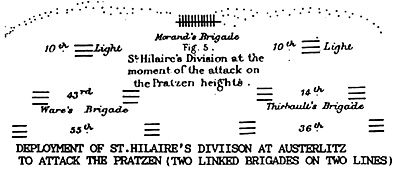 DIAGRAM 2. SAINT HILAIRE'S DIVISION FOR THE ATTACK ON THE PRATZEN WAS
FORMED ON 3 LINES BY LINKED BRIGADES. EACH BATTALION IN OPEN COLUMN OF
DIVISIONS COULD QUICKLY FOR SQUARE/
DIAGRAM 2. SAINT HILAIRE'S DIVISION FOR THE ATTACK ON THE PRATZEN WAS
FORMED ON 3 LINES BY LINKED BRIGADES. EACH BATTALION IN OPEN COLUMN OF
DIVISIONS COULD QUICKLY FOR SQUARE/
St. Hilaire was not attacked by cavalry but Lannes was and his infantry repulsed the charge and inflicted heavy casualties to the attacking Russian cavalry.
Another significant factor in successfully repulsing cavalry was the increased discipline and training of the regular infantry of practically every nation fielding well trained infantry.
It takes considerable more discipline to stand and await cavalry -- without firing prematurely -- than to attack and/or get involved in a fire fight. That was demonstrated time and again by the well-trained British infantry.
Back to EEL List of Issues and List of Lochet's Lectures
Back to MagWeb Master Magazine List
© Copyright 1995 by Jean Lochet
This article appears in MagWeb (Magazine Web) on the Internet World Wide Web.
Other articles from military history and related magazines are available at http://www.magweb.com